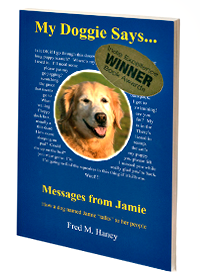Hi! This is Callie writing again. Fred’s in town, but I thought I’d just jump in and tell you how I’m feeling about my crate training.
I’m a little out of breath, because Fred and I just finished a one-on-one soccer game. Fred’s getting better, but he’s still no match for me. I’m tons faster and I can really control the ball under my tummy.
First, let me be perfectly clear about one thing: I really like my crate. It’s plenty big, although Fred and Barbara had to upsize a few months ago, because I grew so fast. Also, it has my nice puppy pad inside, which is great. A few of my toys are always in it, too. I eat all my meals in my crate, and I sleep in it every night.
A few weeks ago, Fred and Barbara let me try sleeping wherever I wanted to sleep in their bedroom. But it didn’t work very well. There were too many places to choose from, and I just kept bouncing off the walls. So it was back to the crate, which is fine with me.
The good news is that Fred and Barbara are letting me spend a lot more time out of my crate. I guess I earned the privilege by showing that I’m house-trained and I don’t mess with as much stuff as I used to. Like I don’t chew on Barbara’s plants as much as I did when I was younger.
Lots of folks come to Fred’s blog wondering how long a puppy, or a grown dog, should be crate trained. Here’s a fun Internet forum with some good ideas. I guess the answer is all over the map. Some dogs spend at least some time in their crate even when they are full-grown. One person took the door off the crate so her dog could come & go when it wanted. That sounds pretty good to me.
You’ll notice in these forum comments that dogs do better outside the crate if they’re getting lots of good exercise. I go for a three-mile walk almost every morning, so that’s probably helping. I’m pretty mellow when I get back.
I don’t really want to move out of my crate. But I am enjoying being out of it more. Right now, I’m in Fred’s office and we’re playing “fetch” with my Dodo Bird. I’m trying to train Fred to understand that when I bring my toys to him, I’m trying to get him to play with me.
I’m trying to show Fred & Barbara that I’m more responsible now & won’t get in trouble as much. It seems to be working; they keep giving me a little more freedom around the house.












